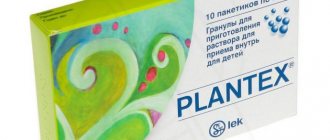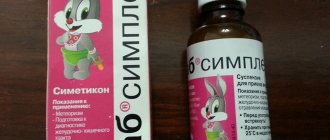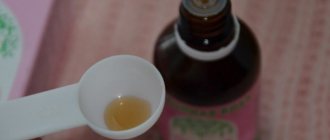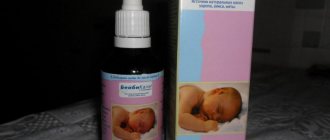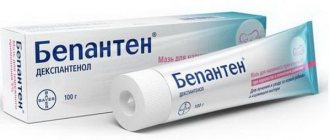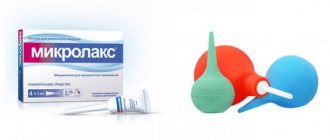Causes of colic in newborns
In newborns, the functioning of the gastrointestinal tract is not yet fully formed.
A child is born with an immature enzyme system and intestinal microflora, and unregulated processes of absorption and digestion of food. Intestinal motor activity is also still inhibited.
All this leads to the formation of fermentation and gases in the gastrointestinal tract, causing pain and colic.
This is due to the period of restructuring of the newborn’s body. As soon as the enzymatic system is improved, the child will no longer wake up from pain associated with bloating.
Almost eighty percent of babies experience colic in the first three months of life, associated with adaptation to a new diet (breast milk or formula).
Useful article? Share the link on VKontakte
And so, the cause of colic is the immaturity of the digestive system. Plus, stressful situations associated with new impressions are added here.
The period when relief occurs shows that the gastrointestinal tract has begun to independently cope with all types of enzymes found in breast milk or infant formula.
During this time, the nervous system of newborns becomes more adapted to the environment.
The baby's condition depends entirely on the well-being of his mother. If colic is directly related to the mother's diet, it is necessary to reconsider her diet.
Remove foods that cause gas in the newborn.
It is quite easy to determine that newborns have gas and colic. Usually the baby begins to behave restlessly, twist his legs and press them towards the tummy, scream loudly and cry.
After some time, the baby may calm down, but then the pain appears again.
Your baby may spend a lot of time lying down. Due to prolonged lying down, digestive processes can cause discomfort.
When experiencing pain from colic, a child may cry a lot, at these moments he swallows another portion of air, which can cause another attack of colic.
Infant colic can also occur if the baby is overfed.
In the stomach, when excess food is received, there are not enough enzymes, and then the excess food begins to ferment, thereby causing gases that begin to put pressure on the intestinal walls and nearby organs.
Execution technique
The mother’s hands must be warm when the manipulations begin. You can also apply a warm (not hot) diaper to your baby’s tummy for a few minutes. Once you have warmed your own hands and your baby’s belly, you can begin.
- Soften your hands with cream or oil (if you don’t have a massage oil, you can use any herbal one). Apply a little product to your tummy and distribute evenly.
- Massage the abdomen with light circular movements with an open palm, without touching the umbilical wound. Avoid pressing with your palm: pressure can cause an attack of pain in the baby. The exercise is performed 10-12 times.
- Using your index and middle fingers, with slightly more noticeable pressure, begin to “draw” spirals on your belly - from the navel to the ribs, increasing each subsequent turn.
- The next exercise will resemble the movement of the blades of a water mill. Place both hands on your tummy, palms down. One hand massages the transverse muscles, and the other - the obliques.
- With one hand, grab the baby's legs in the shin area, and with the other, start moving from the lower left corner of the abdomen up to the diaphragm, parallel to it and down. Thus, you draw the letter “P”. It is important to start on the left side, from the descending part of the intestine. This will help “push” the accumulated bubbles of intestinal gases to the natural physiological outlet to the outside - to the anus.
- Place the baby on its side. Gently move your open palm along the back, moving to the side muscles. In this case, with your second hand you need to press your legs bent at the knees towards your stomach. After 10-15 such exercises, turn the child over to the other side and repeat again.
Almost all newborns - about 90% - suffer from intestinal colic to one degree or another. The reason for their occurrence is physiological in nature and is explained by the period of adaptation of the child’s digestive tract to new conditions. There are many ways to alleviate a baby’s condition, and massage for colic in newborns is considered one of such effective and affordable methods.
Colic in newborns is a painful, spastic contraction of the intestinal muscles, which occurs due to the effect of increased gas formation on the walls of the organ. Simply put, the baby forms a considerable amount of gas bubbles inside the intestines, which put pressure on its walls, causing spasms and pain. What is the task when performing a massage for colic in a newborn? It is necessary to speed up the removal of gases from the digestive system and gently stimulate peristalsis so that the children's intestines can cope with the problem on their own. When the gases come out, the baby will calm down - after all, there will be no more pain and spasms.
Colic is the result of a newborn's digestive system not being fully mature. Nervous and muscle regulatory mechanisms do not work well enough, enzyme activity is weak. Of course, all processes will return to normal after some time, but at first the newborn develops colic, from which the child suffers.
Immediately after birth, the baby is offered a new type of nutrition - breast milk or formula (if there is no milk). A child’s body needs time for digestive processes to improve and for the enzymes necessary for digestion to appear. During this period, colic may occur in newborns.
Especially often, colic in newborns occurs when the baby is not breastfed correctly, when the baby swallows a large amount of air along with the milk. Also, colic can appear if the baby is not at the breast for long and only manages to suck out the initial volume of milk, which is especially rich in carbohydrates - and carbohydrates, as is known, can cause an increase in the formation of gases.
The feeding habits of a nursing mother also play an important role. It's no secret that almost everything a mother eats and drinks ends up in breast milk. Many foods that get into milk can also cause colic in a newborn baby.
How to help a baby? First, it is necessary to exclude all possible causes of colic. Secondly, other auxiliary measures need to be taken - in particular, massage for colic in newborns will come to the rescue.
How to help relieve pain symptoms from colic in a baby
First of all, don’t panic, your condition will be passed on to the little one. Take the baby in your arms and only after that do the following procedures with him.
Your calm state and your hands will help him relax and calm down. Lightly stroke your baby's tummy, moving clockwise around the navel.
- Place your warm palm on his tummy, and use the other to slowly rock him.
- You should always have a warm diaper on hand. It can be kept (in winter) on batteries. Take your newborn and hold him close. Place him face down on your hand, as if hanging the baby, and now in this position, slowly rock him. Don’t forget to place a warm diaper under your baby’s tummy to keep him warmer. The heat will relax you and help your problem.
- You can put the child on your shoulder (his face should be on your shoulder). Carry the little one in this position until the “bulk” (air) comes out. It will be audible, the sound is somewhat reminiscent of a burp. Only after the air has come out and the baby has calmed down and fallen asleep, put him in the crib and cover him with a warm blanket.
- It happens that the “bulk” does not come out for a long time. Walk around with the baby on your shoulder, and then put him down and with light massage, rubbing movements, walk in the chest area towards the baby’s neck and shoulder. Then carefully lift it again, and again placing it on your shoulder, carry it around the room. Usually, after several such receptions, the air comes out, and the baby falls asleep well.
- Prepare a hot bath for the baby. The water temperature can be determined using your hand or a thermometer. Place the back of your hand in the bath, and (the area near the wrist in the upward direction) if the water feels pleasant, you can lower the baby into it. After taking a bath, you can give him a massage. Lubricate your hands with baby oil and walk downwards in the tummy area with relaxing movements. This should help your baby get rid of gas. The most important thing for a mother or father is to try to convey their calmness to the child using tangential movements. He will definitely feel it.
- Take your baby in your arms and hold him to your chest during an attack of colic, this will give him relaxation and help relieve colic.
- Your baby should calm down if you place him on your stomach and hold him for a long time. He will be calm and his tummy will be warmed by your warmth.
- For natural abdominal massage, try tucking your baby's knees toward his stomach. Take your right knee and connect it to your left elbow, repeat the same movement with the other knee. We do this kind of gymnastics several times. After which gas and colic will go away on their own.
- Take the baby and place him tummy down in your arms and slowly rock him in different directions. The baby should like this and he will stop being capricious.
- And the last way to help remove accumulated gases is a gas outlet tube. With its help, you can get rid of accumulated gases in a newborn, but this should be done in extreme cases.
The baby may get used to this method and stop trying to do it himself. Then you will not be able to do without the help of a straw.
Take the tip of the gas outlet tube and coat it with Vaseline or regular baby cream. Now very carefully insert into the anus into the anus.
The depth of penetration should be no more than two centimeters; be very careful, as the tube can cause damage to the child. If the baby resists, stop this procedure.
Colic is the accumulation of gas in the abdomen of newborns. When there is a large accumulation of them, spasms occur. They are the ones who bring pain and anxiety to the child.
The body of newborns needs a certain time so that after receiving nutrients through the umbilical cord, it can adapt to a new type of nutrition. With new food, new types of bacteria enter the body.
Quite often, the cause of colic is the incorrect attachment of the baby to the mother's breast.
The baby may not latch onto the nipple properly and may swallow air along with the milk during feeding. This causes bloating and intestinal colic.
Colic may be the cause of a baby's special temperament. Sometimes a child, by crying, can demand to be picked up and show his character. From screaming and crying, he can become overexcited and take in too much air.
Every nursing mother should remember that breastfeeding must be accompanied by a diet for her.
If the mother violated the diet and ate a product that is not acceptable for the baby, colic and gas may appear.
Perhaps the infant's feeding schedule was disrupted. Modern pediatrics has differences in the issue of feeding regimen. The old breastfeeding system, proven over the years, requires strict adherence to the regimen.
Since the interval of three hours between feedings allows time for the food to be digested. And thus the baby’s body is ready for new feeding.
According to the new version, doctors require that the baby be put to the breast upon his first request. In this situation, the food does not have time to be digested and thus a disorder appears in the gastrointestinal tract.
Each mother must decide for herself how to properly feed newborns; to do this, you can try these two feeding methods. And after making conclusions after research, choose what suits your child.
Colic and gassy appear in newborns because the mother ate something prohibited from foods during the feeding period and this product entered the baby’s body with breast milk.
To exclude possible serious problems and subsequent treatment, be sure to monitor your diet and consult your pediatrician about this.
What foods should a nursing mother avoid during breastfeeding?
Foods that can make a baby swell:
- Consuming excessive amounts of sugar, including condensed milk, which has an excessive amount of concentrated sucrose.
- Any flour products.
- Carbonated and soda drinks.
- Any citrus.
- Legumes.
- Cabbage.
- Dairy products. These include milk and cheese with a rapid fermentation process.
- Greens and vegetables.
- Chocolate and chocolate candies.
- Any spices, products containing caffeine.
Treatment of a child with the appearance of gas
To prevent your child from suffering from colic and gas, you must:
- Make it a rule that before you start feeding your baby, lay it on your tummy.
- After feeding, be sure to pick up the baby and carry him in a column while holding him close to you, this will allow the trapped air to escape.
- To prevent your baby from suffering from colic, try to provide him with a healthy diet - breast milk.
- Dill water, chamomile infusion, and fennel tea will help against gas formation in the gastrointestinal tract. All these drugs and other medications can be purchased at the pharmacy (in consultation with your doctor).
The appearance of gas in a newborn is a normal phenomenon that accompanies the process of formation of the gastrointestinal tract. Many parents panic during this difficult period, and this is understandable.
It is necessary, first of all, to calm down and remember that colic and gas in newborns, their treatment must be coordinated with the treating pediatrician.
And above all, this is not a pathology. This phenomenon is temporary, you just need to be patient.
Useful video
Colic that occurs in a baby in the first months after birth is a physiological condition, and not any pathological process.
After birth, the baby's digestive system is not yet fully strengthened, so it functions worse than in adults.
During the process of digesting food, the baby may experience difficulties with bowel movements and gas formation.
These phenomena themselves are considered to be the causes of pain; this is colic in a newborn. To know how to deal with colic in newborns, you need to consult a doctor.
Characteristics of massage and general rules
Massage belongs to the category of therapeutic and preventive. It is used to alleviate the condition of infants who already suffer from the accumulation of gases in the intestines, as well as to prevent colic in babies who have not yet complained of increased gas production.
The massage can be done at home; there is nothing complicated about it. His techniques are simple and understandable; any pediatrician you ask will be happy to show them. But even without the presence of a doctor, the massage technique is not complicated, and we will discuss it in detail below.
Massage helps strengthen the weak anterior abdominal wall, improves peristalsis, promotes the passage of intestinal gases, and helps with constipation in infants, which also occurs almost everywhere at an early age. The release of gases as a result of massaging movements relieves spasms of the intestinal wall, pain decreases and disappears, gases escape outward, the child is able to sleep and eat peacefully.
Treatment of colic in newborns
This condition presents with intense cutting pain near the abdomen.
They are formed due to various circumstances, from overeating or a large amount of air swallowed with food, to psycho-emotional stress and unconscious tension of the smooth muscles of the gastrointestinal tract.
In any situation, the symptoms are quite unpleasant - and the baby cannot withstand it. Accordingly, he will begin to sob loudly and without interruption, as long as he is disturbed by a strange discomfort.
Very often, colic can be associated with constipation.
This can happen due to too frequent feeding of the baby: his stomach cannot have time to process formula or breast milk, but a new portion is already arriving, as a result of which stagnation forms inside the gastrointestinal tract with increased formation of gases.
It must be said that the baby has very weak intestinal muscles and is not able to independently carry out bowel movements, like adults.
The feces themselves should approach the exit from the gastrointestinal tract. Sometimes this is a rather lengthy process, often accelerated by impatient parents through a gas tube.
Colic in a child occurs due to inappropriate formula or inadequate nutrition of the mother.
You should strictly follow the diet that is prescribed for each woman, otherwise unnecessary substances penetrate into the milk and can cause increased gas formation and painful discomfort in the baby.
Very often, colic occurs due to improper feeding. When a baby begins to absorb a significant amount of air with milk, the consequences will not be long in coming.
Taking this into account, the feeding process should be adjusted to avoid these difficulties.
Why do you need massage for colic?
Pain in the tummy with colic occurs due to the fact that gas bubbles stretch the intestines. Spasms and convulsions of the walls of the intestinal tract appear. The baby feels severe pain in the tummy and has difficulty producing gas and passing calla stool.
The baby shows his dissatisfaction in all ways: he cries, kicks his legs and arms, pushes hard
If the mother feeds the baby incorrectly, and the baby eats only high-carbohydrate fore milk, not reaching the fatty hind milk, then this contributes to colic. Lactase deficiency will only worsen the situation.
Gas formation and fermentation processes occur in the baby’s tummy. The baby's abdominal muscles are too weak to cope with so many bubbles on their own. And the presence of a diagnosis of umbilical hernia or diastasis of the rectus abdominis muscles increases the likelihood of colic in a child.
Massage sessions play a huge role in colic:
- Massage relieves spasms, promoting the movement of gases through the intestinal tract and removing them from the baby’s body.
- Working out reflexogenic zones has a positive effect on the functioning of the baby’s digestive system.
- The procedure is excellent for preventing colic. Massage helps food fragments move through the gastrointestinal tract, allows gases to freely leave the intestines, prevents the appearance of spasms, and facilitates the passage of feces.
Possible causes of newborn colic
To fight colic, you need to establish the causes that caused the phenomenon:
- Flatulence, which is caused by maladaptation of the digestive system.
- Unpreparedness of the nervous system.
- Colic may be infectious in nature.
- Allergy to food. Causes of colic in newborns include a change in formula or a transition from breastfeeding to artificial nutrition.
- Swallowing air during feeding, improper positioning or latching of the nipple.
- Dietary disorders during breastfeeding. Often, the provoking factor for colic in a baby is considered to be poor nutrition of the mother.
The exact reasons that cause colic in newborns are quite difficult to establish, and when parents are trying to save their child from suffering, they need to act in a complex manner.
Ways to relieve a newborn from colic
- Massage against colic, which you should learn to do from specialists.
- The mother's diet, which will be suggested by the doctor who has been observing the baby from the first days of life.
- After feeding, it is recommended to hold the baby upright to allow excess air to escape.
- If a newborn behaves restlessly after eating, you need to pick him up so that his tummy is pressed against the adult’s body. Regular strokes on the back will help the baby calm down.
- A balanced diet for the mother will facilitate the baby’s digestion and allow him to receive all the necessary microelements along with breast milk.
Newborn colic: emergency care
First aid for dealing with colic:
- Laying on the stomach. To eliminate bloating and facilitate the release of gases, the baby should lie on his stomach for 15 minutes before feeding. This type of therapy is considered a massage and helps strengthen the intestinal walls.
- Warmer. The baby's colic is relieved when heat is applied to the stomach. A small heating pad will also work. It is added during sleep. When there is no heating pad, it is possible to make a compress from a warm rag. For these purposes, it is heated with an iron or supported by a radiator. In the event of a sudden attack of colic in a baby, when the heating pad is not ready, you should undress the baby and press it to your own naked body. Often this manipulation can reduce pain.
- Massage. It has a beneficial effect on gas release and elimination of bloating. It helps cope with colic in newborns. Circular stroking should be done near the navel in a clockwise direction. The duration varies depending on the baby's mood. Some children can lie still for 30 minutes.
- Dietary nutrition of the mother. Colic in the baby’s stomach does not go away soon when a nursing mother eats foods that provoke the formation of gases. Experienced women, in the process of preparing for motherhood, study the list of foods prohibited during lactation.
- Gas removal. When it is difficult for a child to release gases, a gas outlet tube is used. It must be used according to the recommendations of a specialist. You should not experiment with this device.
How to finish a massage correctly
To complete the massage, you must follow the recommendations:
Proper nutrition
Infant colic can be quickly addressed by proper dietary choices. So, over the course of 14 days, the baby’s condition improves over time, bloating and symptoms of this phenomenon disappear.
However, when an effective remedy is prescribed during this period, the colic will disappear as soon as possible.
Therefore, during the therapy process, attention should be paid to taking the emulsion, reviewing the menu, and eliminating various pathologies.
A food allergic reaction can manifest itself as the body’s response to any product. For colic in children that are caused by a food allergic reaction, a complex of 3 main vectors of therapy is used:
- use of medication;
- dietary nutrition;
- if necessary, enzymes and medications are prescribed that correct the intestinal microflora.
If sensitivity to cow's milk proteins is weakly expressed, it is permissible at the initial stage of therapy to increase the amount of fermented milk products in the daily diet to 1/2 or even 2/3 of the volume.
It is possible to replace cow's milk with goat's milk. If there is no positive result from the use of fermented milk products and there is a pronounced sensitivity of cow's milk proteins, it is necessary to completely remove milk and products based on it from the child's menu.
In case of combined intolerance to cow's milk and soy proteins, the use of a medicinal mixture is prescribed, which is based on hydrolysates of cow's milk proteins.
Medicines for a newborn
Drugs that help treat colic in newborns:
- Espumisan. The product is suitable for children as an emulsion or drops. Espumisan is diluted in breast milk and given to the baby from a spoon. When the baby is bottle-fed, it is permissible to add it to the bottle with the formula.
- Plantex. Includes fennel extract and oil, lactose and glucose. Available as a dosed powder of 5 g. The solution must be made right before use. It helps fight colic in infants, improves food processing and intestinal motility.
- Bobotik. Opaque drops for internal use. The active ingredient is Semiticon. Removes flatulence and improves gastrointestinal motility. Unlike other analogues, it is characterized by lower cost and economy. The increased concentration makes it possible to apply 3-5 drops directly to the mother's nipple before feeding.
- Dill water. It removes increased formation of gases and eliminates unpleasant symptoms. It is also acceptable to use fennel-based children's teas.
These drugs should be used when other drugs have not helped. Complex therapy definitely gives results.
Even if the problem remains, it must be remembered that this is a short-term condition and soon the baby will become calm and cheerful.
Contraindications for carrying out
There is no need to start massage for colic in a newborn if the slightest symptoms of intestinal obstruction or strangulated hernia are observed. You should be especially wary if the following signs appear:
- the abdomen is distended asymmetrically;
- under the palm, strong peristalsis is felt not throughout the entire tummy, but only in one area;
- no stool, no gases for a long time;
- the newborn baby is lethargic, the skin is pale;
- the baby's temperature rises;
- blood is released from the anus;
- a painful lump is detected in the navel area;
- A newborn baby experiences severe, prolonged pain.
If there are such signs, then it is better to show the child to a doctor, and immediately.
In addition, massage for colic in newborns should not be done if there are wounds, rashes, etc. on the skin of the tummy.
Perhaps the most common problem for young parents is colic in the child. Anxiety in the first months of life, high-pitched crying, pressing of the legs towards the tummy, frequency of occurrence and relief after the passage of gases are the main manifestations of this condition.
Intestinal colic is not dangerous, but very painful. To help the child, medications, warming the tummy, changing body position, a gas tube, some exercises and tummy massage are used.
In the animal world, mothers lick their babies. Human hands can be much more effective in relieving a child of colic. When and how to massage the abdomen of a newborn?
Preventing colic in babies
To prevent infant colic, certain precautions must be followed:
- Diet food. When a baby eats breast milk, it is necessary to remove from the menu products that cause the formation of gases in the gastrointestinal tract.
- Gymnastic exercises. We should not forget about a set of exercises for the baby; this is necessary as a preventive measure for the phenomenon.
- Abdominal massage. Light massage after feeding: clockwise in a circular motion near the navel.
- Warm diaper. Before feeding, it is necessary to place the baby on his stomach with bent knees on a warm diaper.
- Proper attachment to the breast. The baby should latch onto the nipple and most of the areola. The pressure must be tight, otherwise the baby may swallow air.
- "Column". After feeding, you need to hold or carry the baby in an upright position for 10 minutes.
- Herb tea. You should drink herbal tea with fennel, anise, and dill seed.
Treatment of colic in an infant at home is considered an extremely important aspect in medical practice, but not only doctors should have knowledge of effective traditional medicine to eliminate this phenomenon in infants.
Therapy should be agreed with a doctor, since most of the components can cause an allergic reaction in infants.
Properly chosen treatment will help eliminate this condition in the newborn as soon as possible.
Useful video
Having colic in a newborn is a fairly common occurrence. Discomfort in the tummy usually begins to torment the baby after the second week of life.
In order to relieve the pain of the baby, parents resort to many different remedies - from a warm bath to taking medications.
In parallel with these techniques for relieving discomfort, tummy massage for newborns can be used.
A lot of literature has been written on this topic, many videos have been made, stroking and kneading the tummy is recommended by leading pediatricians.
Such a procedure can be carried out by a specialist in this field. But a mother, being at home, can also help her newborn.
What is the procedure
- The mother's warm hands are already a good stimulator of the newborn's digestion. Before feeding, sometimes it is enough to place one hand on the baby's stomach and hold for a minute.
- Next, you should stroke the baby's tummy clockwise for a couple of minutes.
- Placing your right hand on the baby's navel, you need to massage the tummy in a spiral upward to the solar plexus.
- Draw the letter “P” with your palm. Putting your hand on the lower right at the groin fold of the newborn, we move up to the right hypochondrium. Next, use your fingertips to move under the ribs, pressing lightly. And then, turning the palm with the fingers to the left, we lower ourselves to the groin area. It is enough to do this movement 3 times very slowly.
- We bend the baby’s legs one by one, pulling the knee towards the stomach.
Such gymnastics allows you to free the intestines from accumulated gases and prevent the occurrence of colic. You can learn how to massage the tummy of a newborn from a pediatrician who is observing the baby by studying information on the Internet, books or videos.
Massage from a pediatrician: video
Why is a tummy massage necessary?
The manifestation of colic is a painful sensation caused by stomach cramps and the accumulation of gas bubbles in the intestines.
The causes of these pains can be very diverse - swallowing air during breastfeeding, problems with peristalsis and intestinal microflora, etc.
The abdominal muscles of a newborn are still very weak and cannot fully support the internal organs. As a result, an umbilical hernia may form, which is also indirectly to blame for colic.
Abdominal massage for newborns helps move gas bubbles in the intestines and make them easier to pass, as well as relieve cramps.
The massage process is recommended to be done for preventive purposes, not only in case of attacks of pain in a child.
This approach will allow food to move freely along its path, eliminate the accumulation of gases and facilitate the process of bowel movements.
Contraindications
Cautions when performing a massage against gas and colic are as follows:
- It is not advisable to touch the liver area. This place is very sensitive, since in the first month of a child’s life this organ protrudes from the hypochondrium.
- Do not press too hard on the baby's tummy. All touches should be soft.
- Performing abdominal massage on a newborn with colic is carried out only after the umbilical wound has completely healed. For the first time, you need to limit yourself to light touches.
- If your child has a high temperature, massage should not be done.
- In case of exacerbations of diathesis and any skin irritations, the procedure is not recommended.
- It is forbidden to give massages for colic to newborns with blood diseases.
To perform all the steps correctly, it is recommended to seek help from a specialist who will tell you in detail how to perform a competent abdominal massage for newborns with colic. If the procedure is performed correctly, the baby will soon stop experiencing pain during digestion and will delight you with his calmness and good mood.
edakarapuza.ru
Preparatory stage
Before you start the massage itself, you need to take into account some preparatory subtleties, namely:
- The room where the massage session is performed should be at a comfortable temperature. This condition is mandatory, because the baby will need to be rid of clothes.
- First you need to warm your tummy. For these purposes, use an ironed diaper or a heating pad wrapped in several layers of fabric. The heat should be distributed evenly and be comfortable (not hot!).
- Make sure your hands are warm. Touching cold fingers makes the baby nervous and instinctively suck in his tummy. That is why the hands of the person doing the massage need to be warmed by rubbing their palms together.
- Find the best location. In general, massage can be performed in any place: on the changing table, bed, mother’s lap. You just have to avoid soft, springy surfaces - they make it difficult to control the pressure force
- Prepare a suitable diaper. Usually, after a massage, the baby releases gases and even defecates. To protect yourself from unpleasant surprises, you need to place a diaper or piece of cloth under the baby’s buttocks.
- Before starting the massage, the baby needs to be held in an upright position. Often the cause of pain is air accumulated in the stomach. Holding your baby upright can help ease the release of air and prevent regurgitation of milk during the massage.
- It is not necessary to use oil for massage. But if such a desire arises, it is better to give preference to natural base oils - olive, sesame, etc.
Before using a moisturizer, it must be tested. A drop of oil is applied to the skin of newborns, massaged and the reaction is checked after 15 minutes.
If allergic manifestations are not observed, the product can be safely used during a massage.
Preparing for a massage
In order for the massage to have the desired effect, it is important to prepare the room, the child and your own hands for the procedure.
There are several rules that must be followed:
- Before the massage, warm your baby's tummy for one to two minutes. You can use a warm diaper, ironed or heated on a hot radiator.
- Place the diaper, folded several times, on the abdomen and press with your hands.
- Hygiene is paramount , so wash your hands with soap and, if possible, treat them with an antiseptic.
- It is not recommended to lubricate your palms with oil or rich baby cream, as the product can increase the intensity of movements during the massage. This will cause additional discomfort for a colicky baby.
- Hands should not be wet or sweaty. It is better to treat your palms with talcum powder or hypoallergenic powder.
- It is absolutely forbidden to massage with cold hands. In this case, the child is likely to worry and cry. Make sure your palms are warm and pleasant to the touch. You can warm up cold hands by holding them under running hot water.
- The massage is done on the naked body. You can leave the diaper, because the successful completion of the procedure will be the release of gas and defecation. If you decide to remove the diaper, place a diaper under the buttocks. This will keep your clothes safe.
- The temperature in the room should be comfortable. Before the session, ventilate the room, but close the window during the procedure.
- It is better to massage on a hard surface. A table or hard sofa will do. Place a thin blanket and a fleece diaper under the baby.
- A great idea would be to massage colic in a warm bath . But make sure that the baby does not get injured or choke. There should not be a lot of water in the bath.
Before starting the massage, hold the child in an upright position for several minutes. This will prevent regurgitation during the procedure and allow excess air to be released from the stomach.
Preventive massage is done daily. Its frequency reaches up to six times a day. At least one hour must pass from the moment of eating.
Newborn massage using Dr. Komarovsky’s technique is effective gymnastics for a child. For information on how to do a relaxing massage for infants with hypertension, see here.
Indications and technique of gynecological massage, all about its benefits in this article: https://vsetelo.com/bolezni/organy-reproduktivnoj-sistemy/ginekologiya/massazh.html
Carrying out a massage - basic recommendations
It is not difficult to massage the tummy with colic in a newborn. Basic recommendations for exercises can be taken from videos on the Internet or consult with a pediatrician. The basic exercises are:
- Initially, you need to lightly stroke the baby's belly, gradually increasing the pressure and moving on to pressing. An adult folds his palms into a “house” and places them in the area of the newborn’s navel. Next, apply light pressure with the ribs of your folded palms. After this, several pressing movements are made from right to left (this is how the large intestine is located). Each cycle of pressure should be completed with soothing strokes. Important! When performing pressure, it is unacceptable to use the area of the right hypochondrium - the baby’s liver is located there.
- Use your palms to lightly stroke from top to bottom from the ribs to the groin area. Next, one palm is placed on the stomach, and the second one strokes the oblique abdominal muscles, first on one side and then on the other.
- Another effective technique is counter stroking. The massage therapist's left hand moves upward, and the right hand moves downward. After this, the tummy is stroked in a circle - first, alternately with each hand, then with both hands together.
- Stroking, imitating drawing the letter P.
It is carried out in three stages:
- Using the palm of your right hand, stroke your tummy on the left side.
- A “corner” movement is performed from the right hypochondrium to the left side.
- “Bringing out” the letter P. The hand moves along the right side to the left side, then from the left side downwards.
Pinching or spiraling movements around the navel. The massage therapist seems to be drawing flower petals.
Important! All movements of the massage therapist’s hands should be made in the direction of food movement, and not against it. With this approach, the baby’s intestinal motility improves and the baby forgets about colic much faster.
The final movements of the massage therapist’s hands should be soothing and light. The palms move from left to right.
After completing the massage, you can stretch the baby’s back from the shoulder blades to the pelvis. This will serve as additional stimulation for the abdominal wall.
If your child is constipated, you can work on his legs by doing exercises that imitate cycling, squats, or tucking his legs towards his tummy.
Massage technique
- Before starting the procedure, stroke the baby's tummy with your palm in a clockwise direction. The hand goes around the navel and stops at the left hip.
- Next make the “letter P” element. Draw this letter from the lung and hypochondrium of one side to the lung and hypochondrium of the other.
- Place the crumbs on your stomach, with your legs bent at the knees. Stroke the back from top to bottom several times. This position creates a certain pressure on the tummy.
- Next, lightly stroke the pelvic bones in the direction from the tummy to the back. This element promotes bowel movements.
- Turn the baby onto his back. Start by tapping the tummy and gently pinching. Then bend your index finger and circle the navel with a phalanx five times clockwise.
- The “house” massage element will facilitate digestive processes. Raising the child slightly, place your palms under the back, and then make sweeping movements with your hands along the oblique abdominal muscles. Finish the element by joining your palms at the navel.
- Mill element. Place your palms across the baby's tummy. Using your hands alternately, perform stroking movements with slight pressure from the barrels to the middle of the peritoneum. Stroking can be replaced by pinching around the navel in a clockwise direction.
- Bicycle element. This exercise is great for getting rid of gas and strengthening your abdominal muscles. Bend each leg in turn and press it to your chest.
- Folding element. Gently pull the baby's legs toward the head. This puts pressure on the abdominal muscles, but relaxes the anal muscles, which leads to the natural release of gas bubbles.
Another way to alleviate a child’s condition is to give him acupressure. Its goal is to irritate skin receptors, through which commands are sent to the spinal cord and brain.
Movements used during the procedure: pressing on certain points and gently rubbing them.
- Hands. Rub your baby's palms together. Apply pressure to each nail and massage it. Make rubbing movements with your hand from hand to shoulder.
- Face. Impact the point located in the middle of the chin. Then rub the bridge of your nose pointwise. Press down on the wings of the spout. Work on the lobes and the point near the tragus.
Before you start the massage, watch a training video on how to massage the tummy for colic in a newborn.
Additional recommendations
- Don't get carried away. In total, all actions of the massage therapist should not exceed 5-6 minutes.
- Do not apply pressure to the child’s liver or genital area.
- Observe the child's condition. If the baby is pale and lethargic, and the pain does not go away even after a massage, this is a reason to immediately consult a doctor.
- Light massaging of the tummy is recommended every day so that the baby can get used to the new sensations. Over time, the baby loses the desire to be capricious during classes.
- The first massage session is best done in the presence of a pediatrician, if possible.
Available contraindications
And although exercises to relieve tummy pain are undoubtedly a great help for the baby, they must be performed with caution. In some cases, massage should be excluded altogether.
You should not perform the movements if:
- The baby recently ate a big meal. It is unacceptable to massage on a full stomach. The optimal time is an hour before or after a meal.
- The newborn exhibits acute manifestations of diathesis.
- The baby has been constipated for a long time.
- The navel area can be felt tense, and sometimes a lump can be felt in this area.
- There is bloody discharge from the anus.
- The child suffers from infectious diseases or pathologies of the cardiovascular system. In such cases, massage should be performed exclusively by a specialist.
Massage is a good panacea for tummy pain and colic in babies. Nowadays, it is not difficult to find information about massage techniques - the Internet is replete with relevant videos.
An important condition is to comply with safety precautions and all necessary recommendations during classes.
Recommendations of Dr. Komarovsky
Pediatrician Evgeniy Olegovich has a whole proprietary system of care for infants, which includes all the nuances of feeding, bathing, swaddling and massage for the tummy (including colic).
Dr. Komarovsky advises new parents the following tips for conducting a session for newborns:
- The baby is fed an hour before the procedure;
- before a colic massage, you should prepare the child, talk to him tenderly, play - mood plays an important role in achieving positive results;
- The procedure for the abdomen begins with light touches and strokes so that the newborn’s body gets used to unfamiliar sensations;
- The massage therapist's hand should move in the direction of the blood flow.
